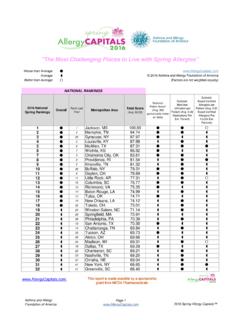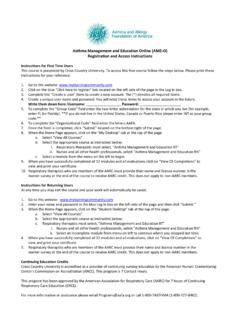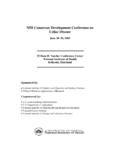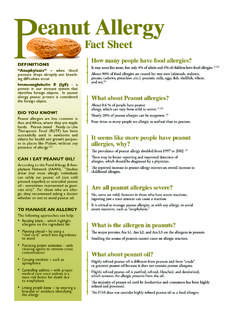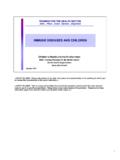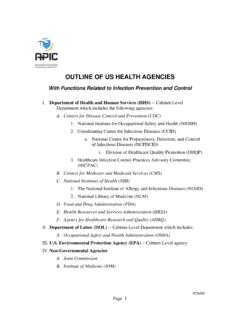Transcription of The Asthma and Allergy Foundation of America …
1 Ethnic Disparities in the Burdenand Treatment of AsthmaTheAsthma and Allergy Foundation of AmericaThe national pharmaceutical council January, 2005 by the Asthma and Allergy Foundation of America and the national pharmaceutical CouncilAbout the Asthma and AllergyFoundation of America ( )AAFA is the premier patient organization dedicated toimproving the quality of life for people with Asthma andallergies and their families through education, advocacy, andresearch. AAFA, a not-for-profit organization founded in1953, provides practical information, community basedservices, support, and referrals through a national networkof chapters and educational support groups. AAFA alsoraises funds for Asthma and Allergy the national PharmaceuticalCouncil ( )Since 1953, NPC has sponsored and conducted scientific,evidence-based analyses of the appropriate use ofpharmaceuticals and the clinical and economic value ofpharmaceutical innovations. NPC provides educationalresources to a variety of health care stakeholders, includingpatients, clinicians, payers, and policy makers.
2 More than 20 research-based pharmaceutical companies are membersof report was prepared by AAFA Policy Director Mo Mayrides and NPC Vice President Richard Levy incollaboration with SCRIBCO. Deborah Kline and JeanPolatsek of NPC contributed editorial support and AnjuKanumalla in association with SCRIBCO provided medicalwriting and NPC thank the following individuals for theirgenerous time, advice and expertise in reviewing the factualcontent of this paper: Peter Gergen, MD, MPHM edical OfficerAsthma, Allergy and Inflammation BranchAsthma and Inflammation SectionNational Institute of Allergy and Infectious DiseasesNational Institutes of HealthDavid L. N ez, MD, MPHC hief, California Asthma Public Health InitiativeMedicine and Public Health SectionCalifornia Department of Health ServicesAny errors in this publication are the responsibility of AAFAand copies of this report may be ordered fromAAFA or NPC. Please address inquires to: Asthma and Allergy Foundation of AmericaAttn: Mo pharmaceutical Council1894 Preston White DriveReston, VA Findings In the United States the burden of Asthma fallsdisproportionately on the black and Hispanic largelyPuerto Rican populations, and especially on minoritychildren.
3 These groups have disproportionately high ratesof poor Asthma outcomes, including hospitalizations anddeaths. This burden has environmental, socioeconomic,and behavioral causes. As much as 40 percent of the risk of Asthma in minoritychildren is attributable to exposure to residential allergensthat could be reduced, if not eliminated. Access to care ishampered by socioeconomic disparities, shortages ofprimary care physicians in minority communities, andlanguage and literacy barriers. A pattern of health carebehavior characterized by the underuse of long-termcontrol medications and a reliance on episodic andemergency care is common in black and HispanicAmericans with Asthma . Underuse of Asthma medicines, especially of long-termcontrol medications, is more common in minority than inwhite children. Specifically, minority children are less likelythan white children to use inhaled corticosteroids, whichare recommended long-term control medications. Underuse of Asthma medications can reflect breakdownalong the sequence of behaviors required for adequatetherapy: (1) under-prescribing, (2) not filling prescriptions,and (3) poor compliance with filled prescriptions.
4 Failure ateach of these stages has been reported for minoritychildren with Asthma , in some cases at a higher rate thanfor white children. Adherence to Asthma medication regimens in minoritychildren may be compromised by their parents beliefsabout the role and usefulness of medications, concernsabout adverse effects, poor literacy, and distrust of andpoor communication with physicians. Individualized,culturally sensitive communication with minority familiescan help avoid these problems. Increasing theuse of long-termcontrolmedications iskey to reducingdisparities in theburden useof suchmedications, especially within the context of asthmamanagement programs, can reduce the use of emergencycare and alleviate the burden of childhood Asthma inminorities. Asthma education and management programs designedfor minority groups can teach them how to use medicationinhalers correctly, correct false impressions aboutmedications, and explain the role of environmental number of such programs have been tested, particularlyamong minority children, with demonstrable success.
5 Thewidespread adoption of such programs could potentiallyalleviate a large proportion of the burden of Asthma inminority children and the United States the burden of Asthma fallsdisproportionately on the black and Hispanic largely PuertoRican populations. This disparity is the subject of thisreport. Although the report is concerned with minoritypopulations as a whole, much of the material presentedapplies specifically to minority children, who are mostaffected by and Puerto Rican populations have disproportionatelyhigh rates of poor Asthma outcomes, includinghospitalizations and deaths. Much of this disparity has beenattributed to unequal access to preventive care. Black andPuerto Rican children characteristically under-use routinehealth care services and overuse emergency care servicesfor Asthma . Environmental, socioeconomic, and behavioralfactors all contribute. Childhood Asthma is closelyassociated with environmental exposures, particularly toresidential allergens, that could be reduced if not programs designed to control Asthma andprevent symptom outbreaks focus on avoidance ofenvironmental triggers and proper use of asthmamedications.
6 Effective medications are available for the long-term controlof Asthma and for quick relief of symptom of these medicines, especially of long-term controlmedications, is more common in minority than in whitechildren. Specifically, minority children are less likely thanwhite children to use inhaled corticosteroids, which arerecommended long-term control medications. Theconsistent use of these medications, especially within thecontext of Asthma management programs, can reduce theuse of emergency care and alleviate the burden of childhoodasthma in report contains three chapters, the first of whichdiscusses disparities in the burden of Asthma on the blackand Hispanic populations as compared with the whitepopulation. The second chapter discusses possiblehereditary, environmental, and behavioral causes of thesedisparities. The third chapter discusses ways in which theseasthma disparities may be of medications in reducing Asthma disparities Asthma can be controlled with medications.
7 Quick-relief drugs are for the immediate relief of symptoms, and controller drugs are for the long-term control of persistent Asthma . Black and Hispanic people tend to underuse long-term control medications. They also use fewer of thesemedications than comparable white populations. Failure to use Asthma maintenance medications regularly, as recommended in national guidelines, may explain thehigh rates of emergency department visits and hospitalizations among black and Puerto Rican populations. Underuse of Asthma medications occurs, in part, because physicians may not prescribe long-term controlmedications to patients who should, according to national guidelines, receive them. Even when medications are prescribed, minority children do not always receive them. Adherence to medication is compromised by parental concern about side effects and by not understanding theimportance of using long-term control medications even when symptoms are not present. Culturally sensitive educational programs that target at-risk minorities can reduce disparities in the burden of 1: Burden of Asthma on Minorities.
8 2 Asthma and Its Impact ..3 What is Asthma ? ..3 What therapies are available for Asthma ? ..3 Impact of Asthma on society ..4 Impact on children ..4 Asthma and Minorities ..6 Profile of the minority populations ..6 Hispanic subgroups ..6 Ancestry of Hispanic populations ..6 Burden of Asthma on minority populations ..7 Asthma prevalence ..7 Asthma mortality ..8 Black and white populations ..8 Differences in Asthma mortality among Hispanic subgroups ..8 Use of emergency health care services ..9 Associated mental health problems ..10 Asthma burden in minority groups other than black and Hispanic Americans ..10 Asthma in minority children ..11 Burden of Asthma among black and Hispanic children ..11 Asthma prevalence in Hispanic subgroups ..12 School absenteeism ..13 References ..14 Chapter 2: Asthma Disparities Faced by Minorities ..16 Asthma Risk FactorsHereditary risk factors ..17 Genetic and environmental components of Asthma .
9 17 Differences in responsiveness to Asthma medicines in minority groups ..18 Environmental risk factors ..19 Allergic sensitization in early childhood ..20 Asthma symptoms in childhood ..20 Residential allergens ..21 Inner-city environment ..21 Pattern of Health Care Service Use by Minorities ..22 Useof emergency services ..22 Episodic Pattern of care among black and Hispanic children ..22 Underuse of long-term control medications for Asthma by black and Hispanic children ..24 Asthma medications used by urban children ..26 Disparities in the use of long-term control medications ..27 What explains the underuse of long-term control medications by minority children? ..29 Factors Underlying the Disproportionate Burden of Asthma ..30 Access to health care facilities ..30 Quality of care provided ..30 Urban environment ..30 Shortage of primary care physicians ..31 Health insurance status ..31 Socioeconomic status ..32 Asthma prevalence.
10 32 Asthma mortality ..32 Health care resource use ..32 Culture ..33 Language ..33 Literacy ..33 Attitudes and beliefs ..33 Caretakers of black inner-city children ..33 Attitudes and beliefs of Hispanics ..34 American Indians ..34 References ..35 Chapter 3: Opportunities to Reduce Asthma Disparities ..40 Expanding Education and Outreach Programs in Asthma ..41 Model programs for Asthma education and management ..41 School-based Asthma management programs ..42 Other Asthma management programs for children ..42 Programs to reduce exposure to allergens ..42 Healthy Homes Initiative ..43 Sources of information about Asthma management programs ..43 Improving Minority Access to Quality Care of Asthma ..45 Community-based quality-of-care improvement programs ..45 Culturally sensitive care..45 The Asthma Collaboratives ..46 Efforts at the state and city levels ..46 The need for health insurance ..46 Community health workers ..47 Federal Efforts to Reduce Asthma Disparities.
